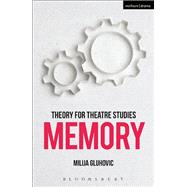- ISBN: 9781474246675 | 1474246672
- Cover: Paperback
- Copyright: 8/29/2019
Starting with a premise that memory holds such a privileged place in contemporary experience, Theory for Theatre Studies: Memory explores the intersections between contemporary theatre and performance, the interdisciplinary field of memory studies, and current preoccupations with the politics of memory across the globe. After offering a fresh critical snapshot of the major theoretical foundations for the study of memory today, the book presents vivid theatrical examples from across the globe and compellingly illustrates the centrality of memory for the theatre as well as the vital role of theatre in making political claims and interventions and transmitting individual and collective memories. Works considered include Luigi Pirandello's Six Characters in Search of An Author (1921) through Tadeusz Kantor's The Dead Class (1975), to more recent case studies such as Brokentalkers's The Blue Boy (2011), Emilio Garcia Wehbi's 12 Indicios sobre el Cuerpoi, and Brett Bailey's Exhibit B (2014).
Part of the Theory for Theatre Studies series which introduces core theoretical concepts that underpin the discipline, Memory provides a balance of essential background information and original thinking, and is grounded in case studies to illuminate and equip readers. Volumes follow a consistent three-part structure: an overview of how the term has been understood within the discipline; current trends illustrated by substantive case studies; and emergent trends and interdisciplinary connections. Volumes are supported by further online resources including illustrative material, questions and exercises.






